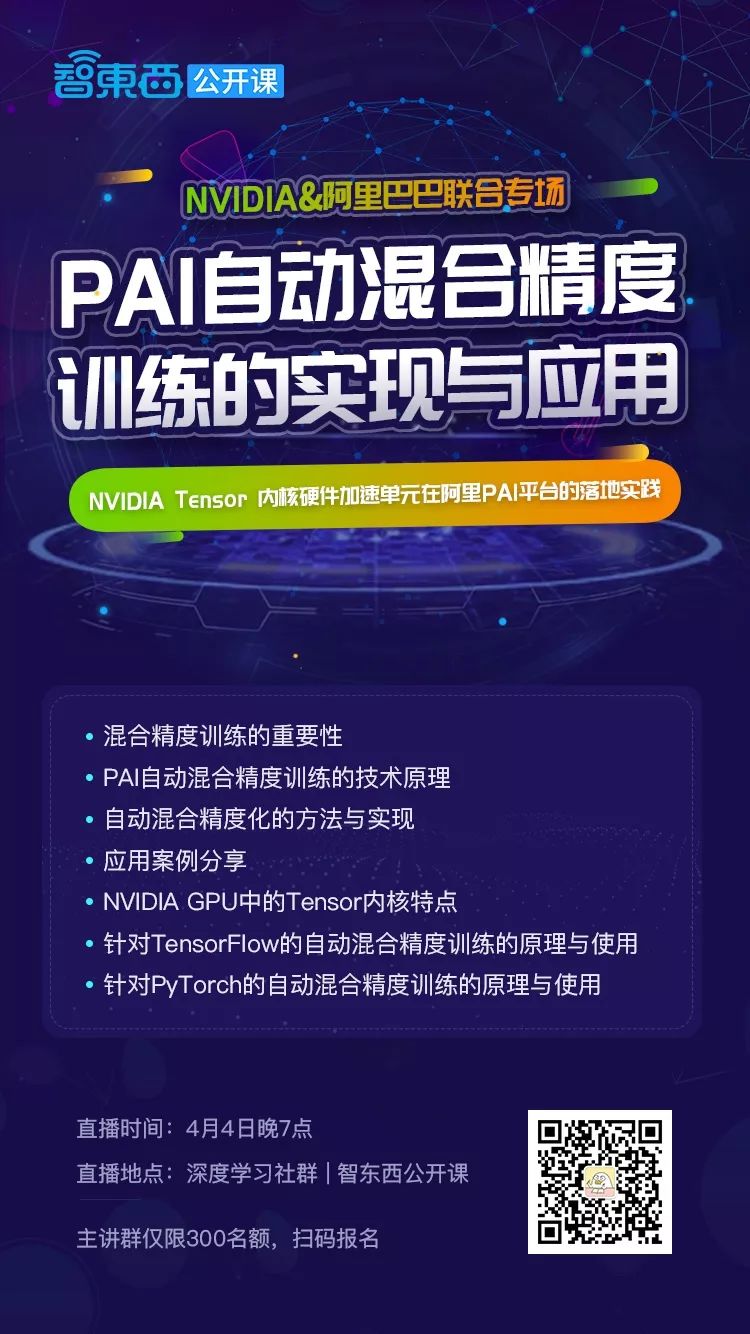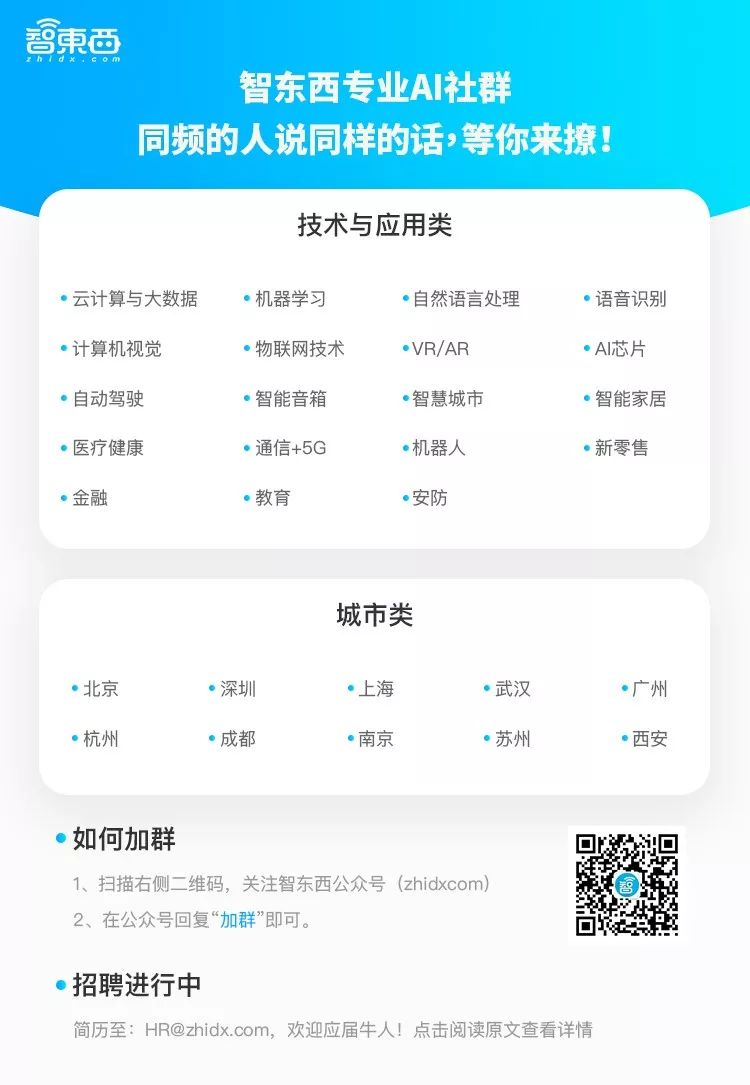Highlights: Detailed analysis of the impact of 5G edge computing on industrial structure.
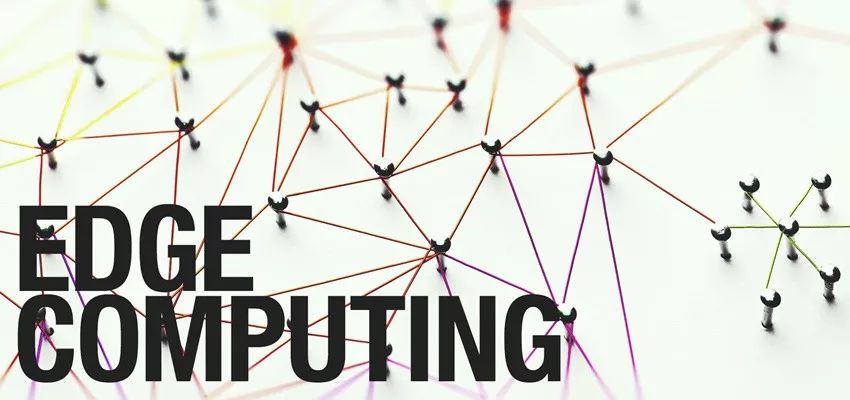
The demand for 5G computing power is driven by two main factors: signal processing and edge computing. On one hand, the increasing demand for communication signal processing imposes new requirements on computing power. On the other hand, 5G is the starting point for IoT innovation, bringing various IoT scenarios. Edge computing is a specific network technology that supports low latency and high density conditions, characterized by strong scene customization. The multi-scenario demand for computing power drives the enhancement of edge computing capabilities. As a new feature of 5G, edge computing will become an important incremental part. Compared to traditional cloud computing, edge computing offers higher security, lower latency, and lower bandwidth costs, making it an indispensable part of the 5G era. Additionally, the demand for computing power brought about by edge computing will also become a significant incremental part of the 5G era.
In this issue of Intelligent Reference, we recommend the report “5G Edge Computing Will Trigger Major Changes in the Computing Power Industry Structure” from Zhongtai Securities, which details the impact of 5G edge computing on industrial structure. If you want to save the detailed content of this article (5G edge computing will trigger major changes in the computing power industry structure), you can reply with the keyword “nc342” on the Zhidx public account: (zhidxcom) to obtain it.

5G Edge Computing Will Trigger New Demand for Computing Power
1. 5G Computing Power Demand Driven by Signal Processing and Edge Computing
The demand for computing power in the 5G era will be influenced by three levels of cloud management and terminal. From the perspective of transmission pipelines, the 5G wireless communication system needs to support a larger bandwidth than the 4G system and large antenna arrays to achieve higher carrier frequencies, which may allow for the construction of much smaller antenna elements. In the future, the connectivity of 5G will become more complex and variable, with a single base station potentially covering millions of users. This scale will significantly increase the requirements for hardware systems. From the user end perspective, in the 5G era, terminals will break through the mobile phone-centric 4G era and expand comprehensively to IoT endpoints, including consumer products, infrastructure products, general products, and specific scenario products, leading to a large number of connections and computing demands. From the platform perspective, in the 5G era, cloud computing platforms will face challenges such as massive device access, large amounts of data, insufficient bandwidth, and excessive power consumption. Edge computing will collaborate with cloud computing, where cloud computing focuses on non-real-time, long-cycle data big data analysis, while edge computing is closer to execution units, capable of rapid response. For latency-sensitive services, edge computing can provide better services to customers.
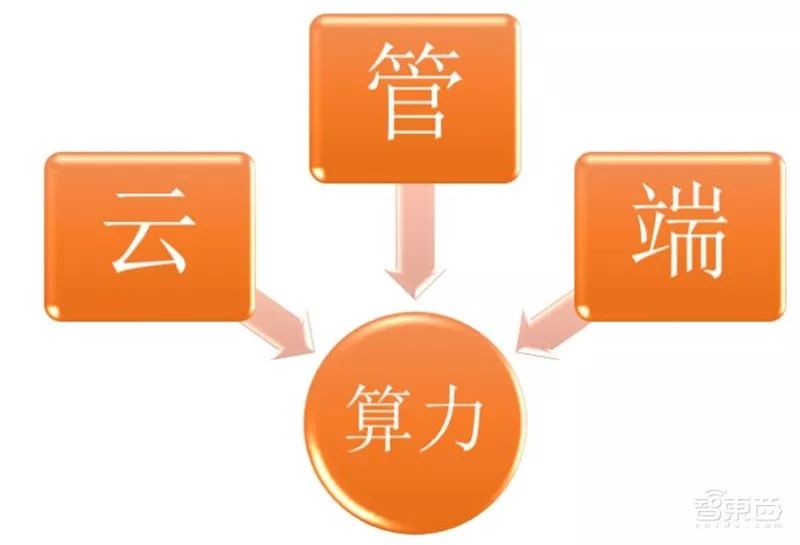 ▲ The demand for 5G computing power is influenced by three major levels
▲ The demand for 5G computing power is influenced by three major levels
Edge computing is a key technology in the 5G era. Edge computing migrates the cloud computing platform from the core network elements to the edge of the wireless access network, close to the terminal, and is established as a key technology for 5G. It will build processing platforms close to users and terminals in the mobile access network, providing IT or cloud capabilities to reduce multi-level transmission of services, alleviating the burden on the core network and transmission. Edge computing is a significant difference that distinguishes 5G networks from 3G and 4G standards, representing a specific network technology that supports IoT technology under conditions of low latency and high density.
 ▲ The introduction of edge data centers will greatly reduce latency and alleviate the overall network’s return and computing pressure
▲ The introduction of edge data centers will greatly reduce latency and alleviate the overall network’s return and computing pressure
The demand for computing power in 5G edge computing is driven by two main factors. On one hand, the increasing demand for communication signal processing imposes new requirements on computing power. On the other hand, 5G is the starting point for IoT innovation, which will bring various IoT scenarios. Edge computing is a specific network technology that supports low latency and high density conditions, characterized by strong scene customization. For example, intelligent driving requires low latency, while smart cities require high bandwidth. The multi-scenario demand for computing power drives the enhancement of edge computing capabilities.
 ▲ Edge computing connects the physical world with the digital world
▲ Edge computing connects the physical world with the digital world
2. Edge Computing as a New Feature of 5G Will Become an Important Incremental Part
Edge computing will promote better development of 5G technology. With the arrival of the IoT era, edge computing will work alongside cloud computing to advance the development of the IoT. The core of edge computing is to migrate computing tasks from the cloud computing center to the edge devices that generate source data. Compared to traditional cloud computing, it has several advantages:
1. Higher security. In edge computing, data only exchanges between source data devices and edge devices, not all uploaded to the cloud computing platform, preventing data leakage risks.
2. Low latency. According to operators’ estimates, if services are processed and forwarded by the MEC deployed at the access point, latency is expected to be controlled within 1 ms; if services are processed and forwarded at the center processing network elements of the access network, latency is about 2-5 ms; even if processed through an edge data center’s MEC, latency can be controlled within 10 ms. For latency-sensitive scenarios, such as autonomous driving, edge computing, being closer to the data source, can quickly process data and make real-time judgments, ensuring passenger safety.
3. Reduced bandwidth costs. Some connected sensors (such as cameras or aggregation sensors working in engines) generate large amounts of data. In these cases, sending all this information to the cloud computing center takes a long time and incurs high costs. If edge computing is used for processing, it will significantly reduce bandwidth costs.
5G drives society from the human-connected era to the IoT era, and the substantial increase in the number of connections, combined with the advantages of edge computing itself, will make it an indispensable part of the 5G era. At the same time, the demand for computing power brought about by edge computing will become an important incremental part of the 5G era.
3. 5G Edge Computing Will Trigger Technological and Market Changes
The characteristics of low latency and high-density connections in edge computing will trigger technological and market changes. From the perspective of chips, edge computing will bring a large amount of data, imposing new requirements on chip processing capabilities. The customized demand of multiple scenarios will require higher flexibility from chips. In the past, in the field of artificial intelligence image learning, GPUs showed great potential, excelling in large-scale parallel computing, which saw explosive growth during this period. ASICs, on the other hand, have strong advantages in niche markets with broad downstream markets, such as the mining machine market.
Looking towards the future IoT era, FPGAs are expected to see explosive growth. FPGAs are programmable acceleration chips with short development times, low bandwidth usage, and low latency, perfectly adapting to the low latency, high density, and multi-scenario requirements of the IoT era. In the future, when a specific niche market scales up, the acceleration chips in that subfield are expected to transform into ASIC chips. However, our overall judgment is that FPGAs will first see explosive growth in the IoT era. From the perspective of servers, edge computing will also bring new changes to the server market, with edge servers gradually being applied and promoted, and some customers opting for hyper-converged edge server forms.

5G Edge Scenarios Drive the Computing Power Industry into the FPGA Era
1. The Deployment of Edge Computing Services Shows Diversified Characteristics
There are significant differences between the human-connected network and the IoT-connected network. Firstly, the IoT will primarily focus on B-end users, differing from the C-end focus of the Internet. Moreover, wireless IoT scenarios will inevitably present themselves in the form of edge networks, which fundamentally differs from the depth of enterprise LAN applications in the Internet. The demand in the Internet era is primarily information-oriented, while the IoT era will primarily focus on intelligent application needs. For different industries and businesses, such as industrial control, intelligent driving, and video surveillance, the positioning of terminal functions, the demand for computing power, and the application methods will be distinctly different. In the Internet era, the Matthew effect is very pronounced, where the winner takes all, but in the IoT era, only companies that accurately grasp the needs of enterprise customers can gradually grow stronger.
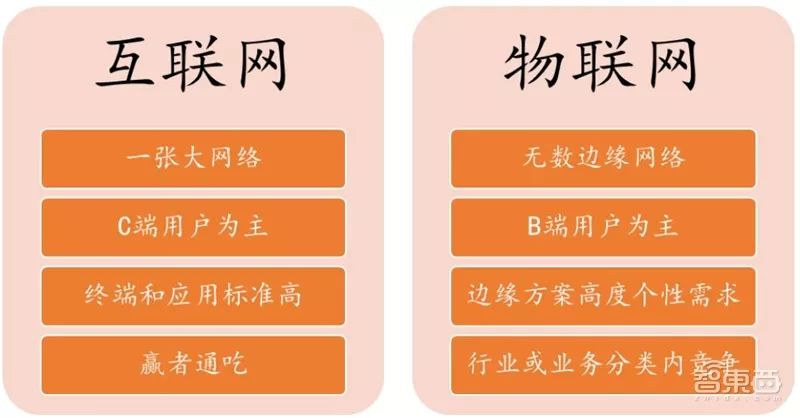 ▲ Differences between human-connected networks and IoT networks
▲ Differences between human-connected networks and IoT networks
The deployment forms of edge computing services are diverse. From the perspective of segmented value markets, edge computing can be mainly divided into three categories: telecom operator edge computing, enterprise and IoT edge computing, and industrial edge computing. Around these three types of edge computing, major ICT, OT, OTT, and telecom operators are building relevant capabilities based on their strengths, laying out edge computing, resulting in six main types of edge computing business forms: IoT edge computing, industrial edge computing, smart home edge computing, wide-area access network edge computing, edge cloud, and multi-access edge computing (MEC). In actual deployment commercial cases, the above six business forms can exist independently or complement each other.
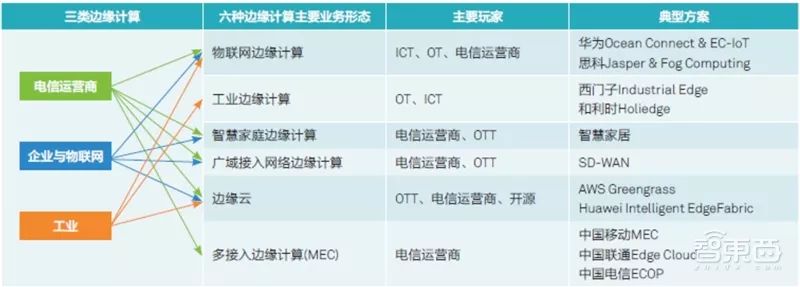 ▲ Deployment forms of edge computing
▲ Deployment forms of edge computing
2. 5G Edge Computing Drives FPGA to Become the New Focus of the Industry
Under the same transistor scale, the more general the processor, the lower the computing efficiency and the worse the energy consumption ratio; the higher the customization, the narrower the application range, but the more “proficient” it becomes in a certain type of computation. When a certain type of computation reaches a certain scale, specialized ASICs represented by high computing power and low power consumption become an extreme choice, such as the mining machines that predominantly use ASIC chips.
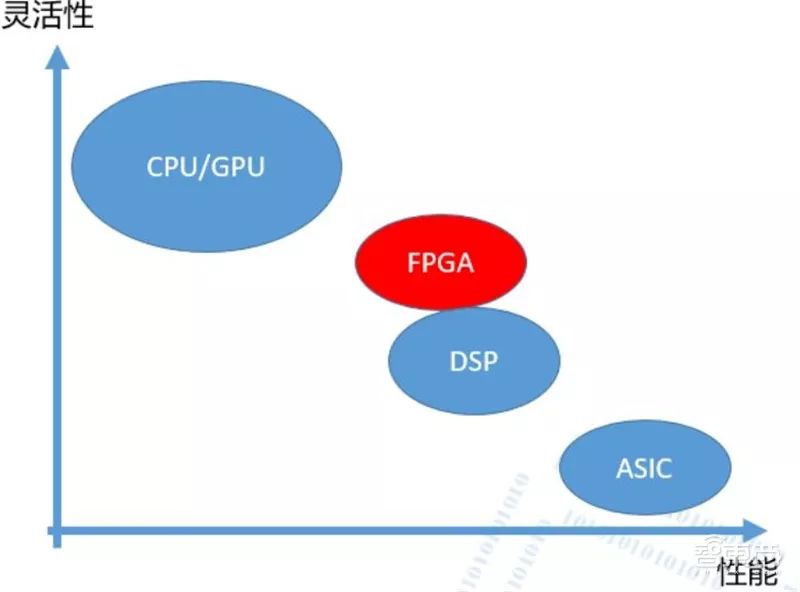 ▲ Differences in flexibility and performance among processors
▲ Differences in flexibility and performance among processors
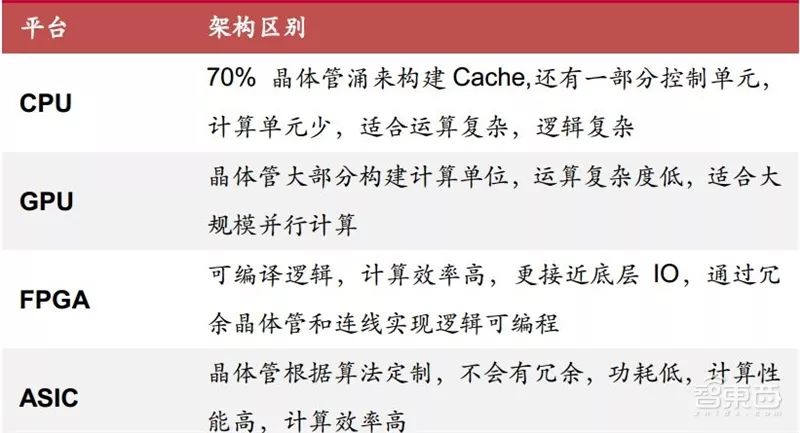 ▲ Differences between CPU/GPU/FPGA/ASIC
▲ Differences between CPU/GPU/FPGA/ASIC
FPGAs can be deeply customized and achieve computing power upgrades. On one hand, FPGAs can be deeply customized for each specific application based on its algorithm structure, even designing dedicated execution logic for each step of the algorithm, avoiding the instruction fetching and decoding processes of general processors, thus achieving high computational efficiency and energy efficiency;
On the other hand, their programmable characteristics allow for loading different computational architectures, realizing the generality of the device itself, which can design structures for image computation and also realize computational structures for tasks that GPUs do not excel in, such as search and encryption/decryption.
 ▲ Advantages and limitations of FPGA
▲ Advantages and limitations of FPGA
FPGAs are better suited for edge computing scenarios compared to other heterogeneous processors. Compared to GPUs, they significantly optimize bandwidth. When using GPUs to enhance computing power, the data for GPU computations needs to share the server’s network bandwidth, PCIE bandwidth, memory bandwidth, etc., which affects computational efficiency and exacerbates the server’s bandwidth bottleneck. Only in scenarios with extremely high data reuse rates, such as CNNs, can they hope to fully utilize computational resources. However, for FPGAs, data required for computation does not need to enter the server, decoupling the hardware acceleration process from the server’s bandwidth bottleneck, avoiding competition with CPU bandwidth. Furthermore, they can take on some computational tasks originally belonging to CPUs, reducing the amount of data entering the server and the complexity of computations, thus alleviating bandwidth pressure.
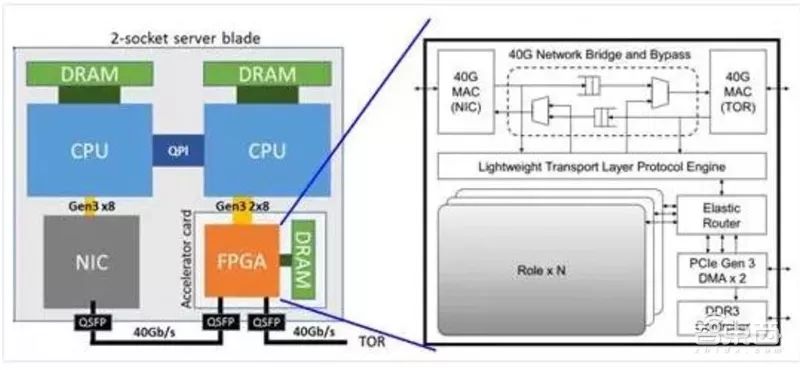 ▲ Hardware acceleration logic in FPGA
▲ Hardware acceleration logic in FPGA
FPGAs have inherent advantages in low latency and stability. On one hand, they integrate a large amount of cache and external DRAM interfaces, reducing interactions with CPUs during the computation process, which avoids resource scheduling and inter-process interference at the operating system level during hardware acceleration, thus ensuring deterministic latency. On the other hand, FPGAs can implement customized pipeline MIMD (Multiple Instruction Multiple Data) designs, achieving stream processing. Intermediate data is passed and interacted between pipelines, reducing reliance on caches and further lowering latency.
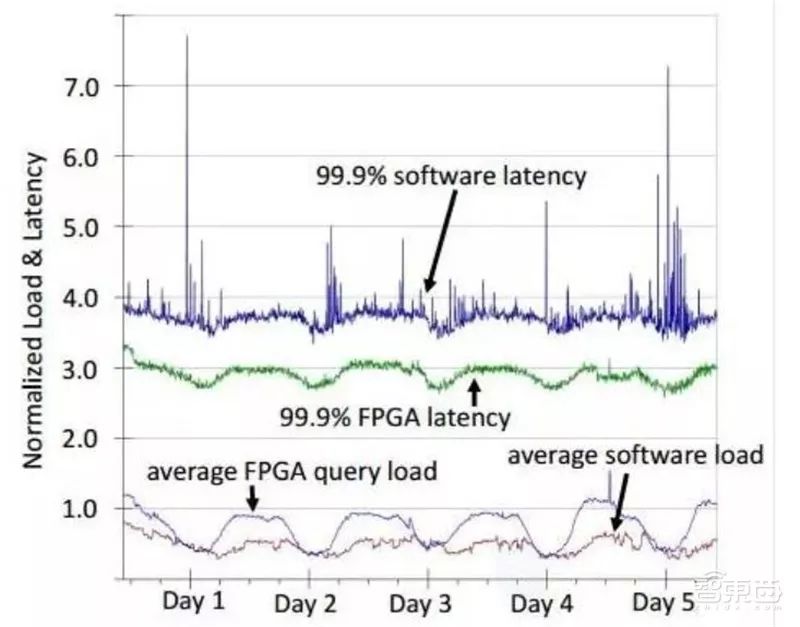 ▲ Comparison of latency and stability of Microsoft FPGA data centers
▲ Comparison of latency and stability of Microsoft FPGA data centers
3. Edge Computing Application Scenarios Clearly Define Computing Power Demand
According to the “China Mobile Edge Computing White Paper” released by China Mobile, the demand for edge computing is most evident in four vertical fields: intelligent manufacturing, smart cities, live gaming, and vehicle networking.
In the field of intelligent manufacturing, factories utilize edge computing smart gateways for local data collection and perform real-time processing such as data filtering and cleaning. At the same time, edge computing can also provide the ability to convert protocols across layers, achieving unified access to fragmented industrial networks. Some factories are also attempting to use virtualization technology to implement industrial controllers, enabling centralized coordinated control of production line robotic arms, similar to achieving separation of control and data transmission in software-defined networks in the communications field.
In the smart city field, applications mainly focus on scenarios such as smart buildings, logistics, and video surveillance. Edge computing can achieve on-site collection and analysis of various operational parameters of buildings and provide predictive maintenance capabilities; monitor and warn vehicles and goods in cold chain transportation; and utilize locally deployed GPU servers to achieve millisecond-level face recognition, object recognition, and other intelligent image analysis.
In the live gaming field, edge computing can provide rich storage resources for CDN and offer audio and video rendering capabilities closer to users, making new business models such as cloud desktops and cloud gaming possible. Especially in AR/VR scenarios, the introduction of edge computing can significantly reduce the complexity of AR/VR terminal devices, thereby lowering costs and promoting rapid development of the overall industry.
In the vehicle networking field, the demand for low latency is very strict. Edge computing can provide millisecond-level latency guarantees for automatic/assisted driving services such as collision avoidance and platooning, and can also provide computing power locally at base stations to support high-precision map data processing and analysis, better supporting blind spot warning services.
In addition to the aforementioned vertical industry application scenarios, edge computing also has a relatively special demand for local private networks. Many enterprise users hope that operators can provide diversion capabilities locally in their campuses, allowing the traffic of self-operated business to be directly diverted to the enterprise’s local data center for corresponding business processing. For example, achieving local communication and courseware sharing in campuses, diverting to private clouds for local ERP business in enterprise parks, and providing data services for medical, library, etc., in public service/government parks. In this type of application scenario, operators provide dedicated line services for customers’ local edge computing businesses.
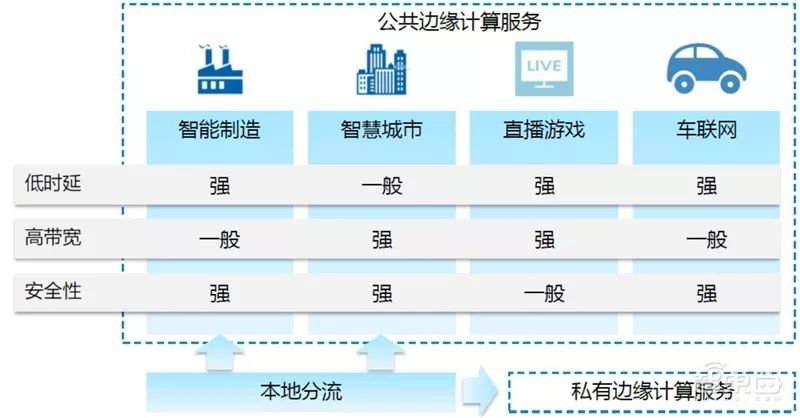 ▲ Typical scenarios of edge computing
▲ Typical scenarios of edge computing
FPGAs are adaptable to various scenarios of edge computing. From several typical scenarios of edge computing, FPGAs are adaptable to different scenarios. Whether in the low-latency intelligent manufacturing and vehicle networking, or high-bandwidth smart cities and live gaming, the inherent characteristics of FPGAs flexibly adapt to these different scenarios.

Edge Computing Expected to Bring High Growth to the Computing Power Industry
1. The FPGA Market is Expected to Experience Multiple Levels of High Growth
The significant changes brought about by edge computing to the structure of the computing power industry are reflected in two aspects: on one hand, base stations primarily perform communication signal conversion, which can be divided into macro base stations and small base stations, with small base stations being the most characteristic access scenario of 5G, expected to become the new entry point for edge computing. On the other hand, servers will see changes in the edge computing landscape, where the processing of large amounts of instantaneous data can be placed at the edge, thereby increasing the importance of edge servers.
According to Zhongtai Securities’ calculations, it is expected that by 2023, the market scale of computing power in the edge computing field will reach $12.7 billion, with a nearly 5-year CAGR of 43.5%. Among them, by 2023, the computing power investment scale at the macro base station end is about $3.125 billion, at the small base station end about $3.75 billion, and at the server end about $5.85 billion.
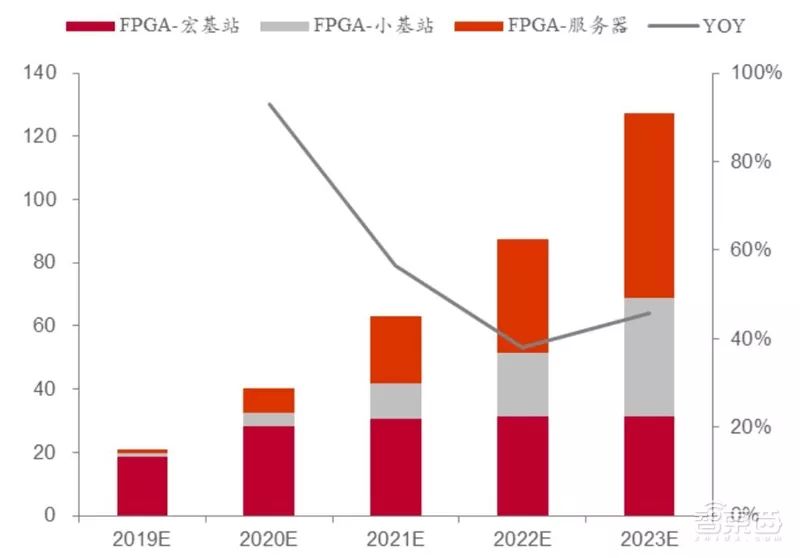 ▲ The market scale of computing power in the edge computing field
▲ The market scale of computing power in the edge computing field
According to Gartner, the global FPGA market size was about $4 billion in 2017. Based on Xilinx’s revenue scale and market share calculations, assuming the global FPGA market size in 2017 was about $4.37 billion (Xilinx achieved revenue of $2.35 billion in fiscal year 2017, with a market share of about 58%). In the past, FPGAs were primarily used in military fields, such as aerospace, aviation, electronics, communications, radar, and high-end beamforming systems. We believe that the growth rate of FPGAs in military fields is expected to remain stable. It is expected that in the future, FPGAs will be widely used in civilian fields, with the global FPGA market size expected to reach about $17.103 billion by 2023, with a 5-year compound growth rate of 21.5%, of which the market size of FPGAs in civilian communication fields is about $12.7 billion, indicating rapid growth.
2. Technological Demand Drives New Changes in the Structure of the Computing Power Industry
FPGAs are expected to shine in the IoT era, with Xilinx as the global leader. The low latency, low bandwidth, and high flexibility characteristics of FPGAs adapt to the customized demands of the IoT era scenarios, which are expected to shine in the IoT era. In the FPGA field, Xilinx and Altera (now acquired by Intel) have long held the first and second positions, with over 6,000 patents. According to the 2017 financial report data, Xilinx’s market share was about 58%. Currently, FPGAs are mainly used in military fields, such as aerospace, aviation, electronics, communications, radar, and high-end beamforming systems, and the civilian field is gradually being opened up.
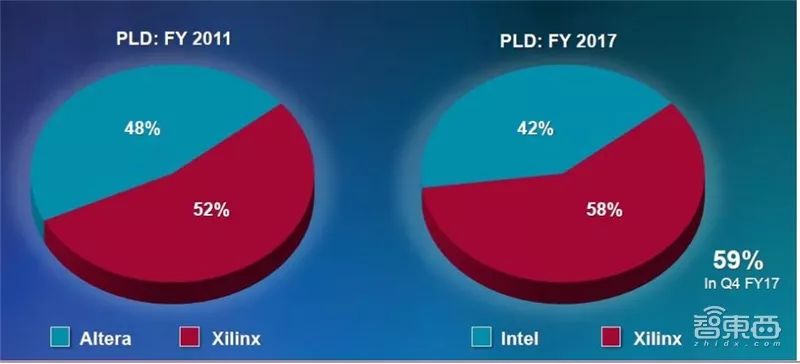 ▲ FPGA market structure
▲ FPGA market structure
GPU: Strong image learning capability, with NVIDIA as the industry leader. GPUs are divided into integrated GPUs and discrete GPUs. The main manufacturers of integrated GPUs include Intel, NVIDIA, and AMD. According to EEFOCUS statistics, Intel’s integrated GPU market share reached 68.1% in 2016. Discrete GPUs exist in the form of standalone graphics cards that can be freely plugged into motherboards with graphics card interfaces, possessing separate memory and not occupying system memory. They are technically superior to integrated graphics cards, providing better display effects and operating performance, with the main manufacturers being NVIDIA and AMD. Intel announced it would enter the discrete GPU market in 2020. According to EEFOCUS statistics, in 2016, NVIDIA and AMD’s discrete GPU market shares were 70.5% and 29.5%, respectively, presenting an oligopolistic market structure.
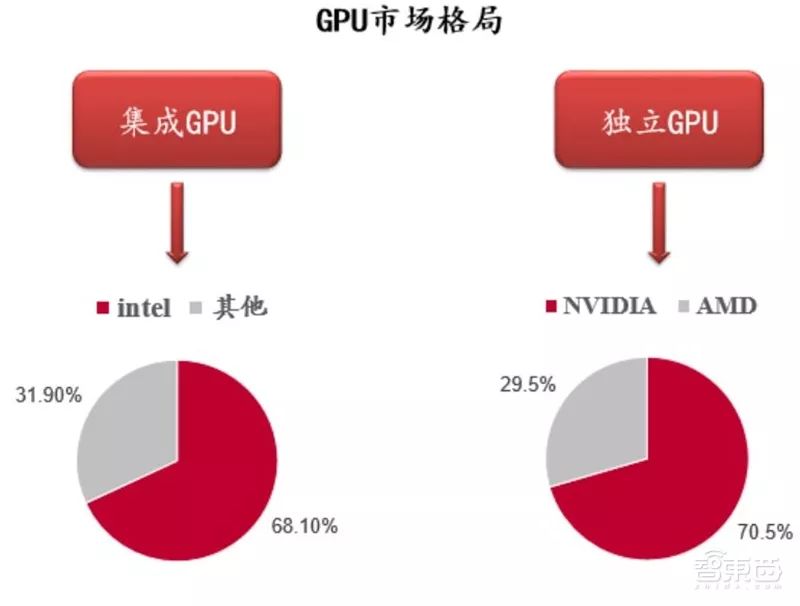 ▲ GPU market structure
▲ GPU market structure
ASIC: High requirements for downstream market space, dominating the blockchain field. Currently, mainstream ASICs include TPU chips, NPU chips, VPU chips, and BPU chips, which are designed and produced by Google, Cambrian, Intel, and Horizon, respectively. Due to the long development cycle of ASICs, only large companies have the funds and strength to conduct research and development. At the same time, ASICs are fully customized chips, achieving the highest operational efficiency in certain specific scenarios. Therefore, when the downstream market space is sufficient in certain scenarios, mass production of ASIC chips can yield substantial profits.
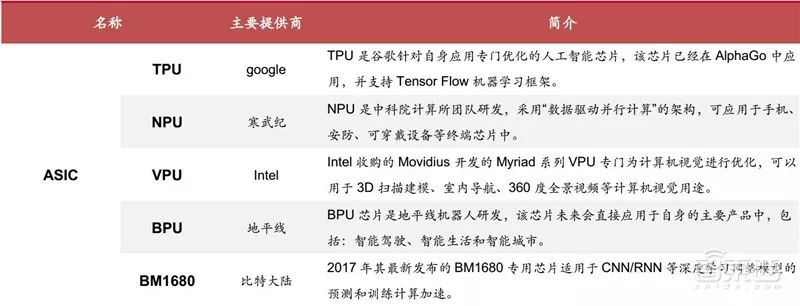 ▲ ASIC market structure
▲ ASIC market structure
The server market: The importance of edge servers will gradually increase, and hyper-convergence is expected to become a trend. The 5G communication network requires decentralization, deploying small-scale or portable data centers at the edge of the network for localized processing of terminal requests to meet the ultra-low latency demands of URLLC and mMTC. The importance of edge servers will gradually increase. Meanwhile, hyper-converged all-in-one machines are expected to see wider application in the IoT era.
3. Edge Computing is Expected to Shape the Value Reconstruction of the Industry in the Next Decade
Edge computing is expected to create value reconstruction opportunities for the next decade.From the perspective of network construction, network construction is expected to shift from traditional operator-planned construction to customer-demand-driven crowd-funded construction. On one hand, operators can save investment costs in network construction, while on the other hand, enterprise customers can participate in network construction according to their needs, coexisting and creating operational value.
From the perspective of network operation, network operation is expected to transform from a centralized management system to a decentralized model, where traditional operators manage a vast network from the provincial backbone to the access point, transitioning to enterprise users managing their own small networks, achieving mobile data transmission services. Operators will focus on core networks and above, managing authentication, billing, security and privacy, and value-added service management, significantly alleviating the operational pressure on operators’ networks and granting enterprises greater management authority over their own networks.
From the perspective of edge business models, edge computing encourages operators to build telecommunications cloud facilities that serve virtualized network elements. Looking towards future industrial internet and emerging businesses such as artificial intelligence, operators need to leverage edge computing to create a computing power plane with full network coverage, providing intelligent connectivity infrastructure nearby for vertical industries. The service content of edge vendors will diversify, specifically divided into several important areas: industry applications, PaaS capabilities, IaaS facilities, hardware devices, data center planning, and network carrying.
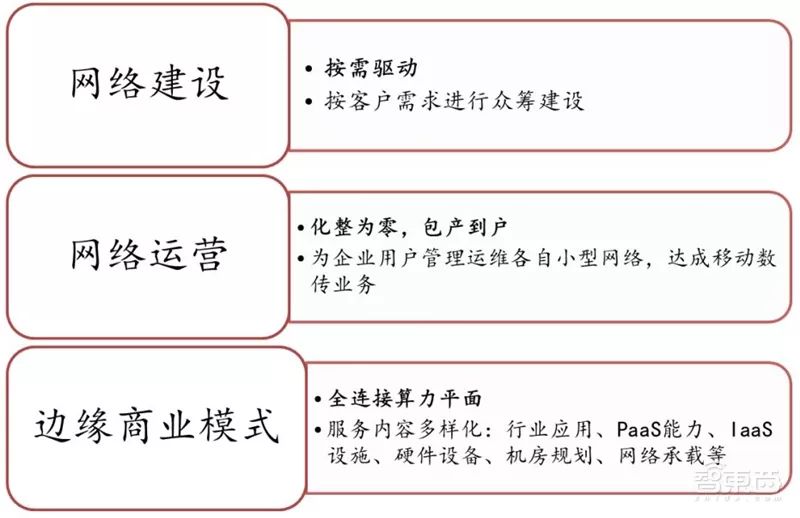 ▲ Value reconstruction opportunities of edge computing
▲ Value reconstruction opportunities of edge computing
Zhi Dongxi believes that there are significant differences between human-connected networks and IoT-connected networks, and the deployment demands for edge computing services exhibit diverse characteristics. Only companies that accurately grasp customer needs can gradually grow stronger. In the field of artificial intelligence learning and image intelligence demand, GPUs have thrived, driving companies like NVIDIA to experience rapid growth. In the 5G edge computing era, FPGAs will become the new focus of the industry. Compared to other heterogeneous processors, FPGAs are better suited for edge computing scenarios, allowing for deep customization based on each specific application and achieving high computational efficiency and energy efficiency. Additionally, compared to GPUs, FPGA architectures can significantly optimize bandwidth and enhance computational efficiency, while having inherent advantages in low latency and stability. Therefore, the diversification of 5G edge scenarios will drive the computing power industry into the FPGA era.
This Thursday at 7 PM, a super public class co-hosted by NVIDIA & Alibaba will be held free of charge, themed “Implementation and Application of PAI Automatic Mixed Precision Training.” Limited spots are available, welcome to scan the code to register!
